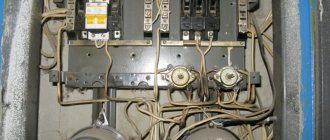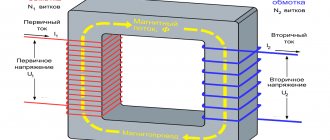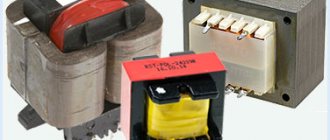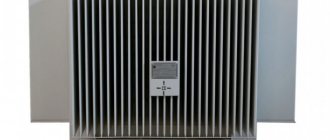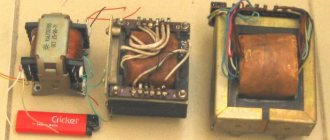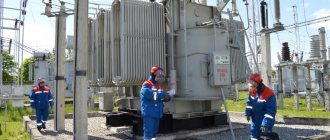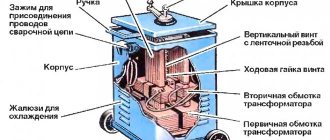A transformer is an element of an electrical circuit designed to convert electricity from one indicator to another. During operation, a current with certain indicators is supplied to the primary winding (facing the electrical circuit). It moves onto the transformer core and interconnects both windings. Next, the current moves through the secondary and is already moving towards the recipient. Thus, businesses, homes, educational and government institutions can use electricity suitable for operating electrical appliances.
Depending on the number of coils, the transformer is a step-up or step-down transformer. The output current can be either lower or higher than the incoming one. If there are more turns on the primary winding than on the secondary, then the transformer is a step-down transformer. If it’s the other way around, then it’s increasing. This does not change the installation of the transformer and the same steps are carried out.
They are used, for example, in transformer blocks that distribute electricity to residential buildings and apartments. A current with one value is supplied to the primary, and a converted current is supplied to our homes, with a rated voltage of 220 volts.
Transformer design
To carry out a full installation of the transformer, you need to understand its design. Despite the complexity of the work performed, it is designed simply.
- Core. An unchangeable element of the transformer block. It is the connecting link between two windings. Made from electrical steel. It is an alloy with silicon, sometimes with aluminum. It is located in a special tank on which the winding terminals are installed;
- Tank. Core reservoir. It has several additional elements on its body: a pipe (required for emergency removal of gas from the tank, which prevents explosions), gas protection (turns off the transformer if damaged), an expander (equalizes the level of oils inside the tank), an oil drain connector (connects the tank with the expander) ;
- Thermosyphon filter. Regenerates oils, preventing moisture or oxidation of the liquid;
- Drain valves. Allows you to regulate the amount of oil inside.
Filling transformer oil
Transformer oil is poured into a power transformer only after it has been checked for compliance with the requirements of the PUE. When adding or filling transformer oil, you must follow a number of rules:
- Before final assembly of a transformer that was transported without oil, it is necessary to wash all elements of its cooling system and the expansion tank with hot transformer oil.
- Oil is added to the equipment through the expansion tank.
- The rate of filling or topping up oil into a transformer should not exceed three tons per hour.
- The temperature of the added oil and the oil inside the transformer should not differ by more than 50C.
- The required oil level in the power transformer tank is determined by control marks, which are applied depending on the ambient temperature.
- After filling the transformer oil, open all available air bleed plugs.
- After twelve hours of settling, check the oil level again; if it drops below critical, top up.
- After settling and checking the tightness of all connections, an oil sample is taken for laboratory analysis.
Acceptable methods of transportation, depending on the type of TB
- Large-sized TB (more than 90 tons) in disassembled form. All leads, expanders, and filter units are disconnected. The oil tank must be filled with some inert gas;
- TB weighing up to 90 tons are also transported partially disassembled, but have a number of assumptions. The tank can be initially filled with oil for ease of subsequent installation;
- Small transformers can be transported fully assembled and filled with oil. Immediately after shipment they can be mounted on the mounting location.
Requirements for the road surface are also given. It should be level and have a slope of no more than 7. Its size is very important, because the lack of proper space for maneuvering the car can lead to additional problems.
Tests and measurements during commissioning
All work on testing the power transformer must be carried out by qualified personnel of the electrical laboratory with the participation of representatives from the installers. During testing, the following quantities are measured and monitored:
- control of the transition resistance of HV and LV windings;
- determination of electrical insulation parameters that characterize its actual state;
- high voltage insulation testing;
- determination of losses in idle mode;
- determination of the winding connection group;
- checking the functioning of the tap-changer and on-load tap-changer;
- determination of the transformation ratio at all stages of the tap-changer and on-load tap-changer;
- monitoring the condition of silica gel and the operation of the forced cooling system;
- hydraulic pressure testing of radiators and tanks.
Upon completion of the tests, a technical report is issued, which contains test reports and a conclusion on the compliance of the installed equipment with the requirements of the PUE, IEC and other regulatory documents.
Preparation for installation
Installation of a transformer requires full preparation. Due to the size and weight of the equipment, it is necessary to prepare a seat.
The preparation stages include:
- Creating a foundation. When installing the foundation, it is important to take into account the oil collection pit. In case of emergency situations, in which a transformer explosion is likely, all liquid will be drained into a special compartment.
- Inspection and revision of the device. It is important that the transformer is fully operational and free of damage. The slightest damage to the winding or core leads to incorrect operation. It is also important to consider the size during installation. The transformer must fit completely onto the landing pad.
- Transportation routes are established. The weight and fragility of the transformer do not allow it to be moved by hand. For convenient transportation, special transport routes are required. The block will be transported along them to its destination.
- Preparing oil tanks. They should be prepared in advance, and temporary tanks are also needed to store oils before filling.
- Preparing silica gel for the absorber.
Transformer assembly
Before installing the device on the foundation, you must additionally mount all the necessary elements on the housing in the following order:
- Radiator units;
- Gas relay;
- Expander;
- Oil level sensor;
- Filters;
- Output contacts;
- Current transformers;
- Control devices.
Some items require pre-installation unpacking. The event requires certain conditions. It is advisable to carry out work in dry, clear weather. If the humidity is more than 85 percent, it is worth carrying out all manipulations in the room.
Transformer installation steps
After all the preparatory work, you can proceed to the installation itself. Here we will use the base that we made in advance.
- Unloading the unit and installing it on the “rails”;
- Transportation of the transformer to the installation site;
- Equipment integrity check;
- Installation of the transformer on the foundation;
- Installation test;
- Commissioning.
Initially, a test input is carried out at idle. Then a load test must be carried out.
Dismantling the transformer
If the transformer is damaged or has exceeded its permitted service life, it will need to be replaced. Dismantling the transformer also requires preparatory work.
During repair work, not the entire unit is dismantled. Separately disconnecting parts of the circuit allows you to fully determine the cause of the breakdown. When disassembling the unit, it is important to mark all parts that can be confused during subsequent installation.
Assembly and installation of power transformer
Installation of power transformers is carried out on a pre-prepared foundation with guides for rollers. After completing the installation work, the rollers are fixed on the guides using special stops. In most cases, the place for installing large large-sized power transformers is an open switchgear (OSD), where preliminary preparation of the area is carried out with the following work:
- Accurate determination of the installation location of equipment, paths and means of transportation to the installation site.
- Arrangement of a foundation with guides on which a power transformer with rollers will be installed.
- Arrangement of a site near the installation sites to accommodate equipment for regeneration and heating of transformer oil.
- Preparation of the necessary tools, devices, lifts and ladders.
- Connection to a stationary power supply system or diesel generator.
Immediately before assembly, all parts of the transformer must undergo careful inspection for defects. The time for installation of components that require depressurization is selected taking into account dry and clear weather. The temperature of the active part of the electrical equipment must be at least +100C. If this requirement is not met, the transformer is heated. The period of time the transformer remains in a depressurized state at a relative humidity of 75% should not exceed:
- 12 hours for equipment with rated voltage up to 35 kV inclusive;
- 10 hours for equipment with a nominal voltage of 110 kV and higher.
The time is counted from the moment the oil is drained or the plug is opened, and the end is considered to be evacuation before filling or the beginning of oil filling.
The assembly of transformers traditionally begins with the installation of cooling radiators, gas relay, expansion tank, oil level relay, thermosiphon and air purifying filters. At the final stage of assembly, the installation of built-in current transformers, inputs and control devices is carried out.
Installation of power oil transformers on rollers or foundations is carried out using cranes, winches, jacks and other means of mechanizing lifting operations. Upon completion of installation of equipment on the foundation or rollers, cables, bus bridges, wires and grounding are connected. All power transformers must have a slight slope of 1-1.5%, which will ensure proper operation of the gas relay.
terms of Use
Dry-type transformers are especially sensitive to high humidity in the room, as well as the presence of accumulations of dust and chemical vapors in the air. The situation is aggravated by the fact that the electromagnetic field created by the transformer electrifies dust particles that accumulate in the most inaccessible places.
Note! During operation, it is important to ensure that condensation does not settle near the insulation during sudden temperature changes.
To prevent these phenomena, the air temperature in enclosed spaces must be maintained within the fixed values established by the standards.
The insulation of the windings may deteriorate on its own during prolonged use, regardless of external reasons. Therefore, its condition should be checked periodically to avoid emergency operation.
Necessary documents for work
Requirements for the installation of transformers are regulated by technical documentation. The following documents are required for installation:
- Technical documentation from the manufacturer as the basis for the installation;
- Development, planning and production work (PPR).
The production action plan is drawn up by representatives of specialized installation companies. Main sections of the plan:
- List of technological equipment;
- Scheme and method of equipment installation on the site;
- Organization of temporary electricity supply;
- The main stages of installation work;
- Safety measures for installation;
- Other information.
A prerequisite for the technical manager before starting work is to familiarize himself with:
- With operational documentation;
- Acts, protocols related to transportation, unloading, storage of the transformer;
- Work schedule.
All assembly work, transportation activities, loading and unloading processes, measures to preserve the power plant, that is, rigging work, must be documented. This is due to the safety of people and the rules for putting the facility into operation.
What are the features
Transformer installation work has the following features:
- installation is carried out at temperatures above 15C, when the material from which the parts are made becomes plastic, which subsequently allows for the assembly and welding of components and parts
- elements with a high melting point (wires, cables) require the creation of certain conditions for cooling, and, accordingly, the creation of a certain insulation, which can be made from oil, vapors or gases
- in some cases, to increase the reliability of operation of individual elements that experience heavy loads, additional elements are used, such as oil-filled bushings, which improves the reliability of equipment operation. As a rule, these are high-voltage bushings and coils.
Installation and connection of the transformer is carried out after all components and elements have been assembled at the manufacturer's factory, however, this does not exclude the possibility of problems and emergency situations that often arise under the influence of external factors, such as high humidity, or the presence of foreign objects inside the elements. To reduce the impact of external factors on the operation of the electrical part, all cracks and holes are sealed and sealed.
Conditions for transportation and unloading of devices
The devices under consideration, in accordance with the requirements of the regulations, can be manufactured either in an open version (without a casing) or in a protected form, which requires the mandatory presence of an enclosing shell. In any of the versions, their transportation can be carried out either by rail or by water (road) transport.
Important! A prerequisite is that before loading the product is covered with a casing and then securely packed in a durable wooden box.
It can be unloaded using a crane, as well as a winch or similar mechanism of suitable lifting capacity. To unload dry transformers, they have special eyes, when using which the angle of convergence of the slings should not exceed 30 degrees.
What to do if dry transformers overheat?
Normal operation of the vehicle is possible only with effective heat removal from external surfaces. This is why it is so important to keep the cores and housing clean. The layer of dust and lubricant that forms during operation significantly impairs heat removal from the working components of the product. To prevent it from overheating, you should:
- Periodically clean the windings and magnetic circuit from dust accumulations.
- Monitor the humidity level in the room.
- Monitor the serviceability of ventilation equipment.
If the product elements heat up excessively, you should consider installing additional ventilation equipment.
